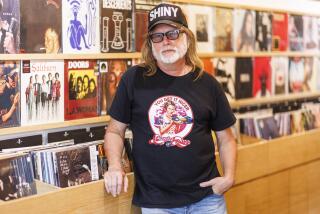Ben Is Dead returns from the dead — for one Sunday, at least
- Share via
Though the L.A. Times and Ben Is Dead were very different publications in the late ’80s and early ’90s, the founder of the latter admits she owes a bit of gratitude to the former for helping get the indie zine off the ground.
“We lost our usual printer, but we made a contact with a guy at the L.A. Times printing plant,” said Darby Romeo, the publication’s co-founder, at the 30th anniversary party for Ben Is Dead, the groundbreaking L.A. journal of music, art and radically confessional writing. “So late at night, he snuck us in and we were able to press off a thousand copies before anyone noticed.
“This is past the statute of limitations, right?” Romeo asked, grinning.
All debts forgiven (at least as far as The Times is concerned). Ben Is Dead, co-founded by Romeo and Kerin Morataya in 1988, is a beloved artifact of ’90s counterculture. Before ending its run in 1999, the DIY magazine featured early interviews with Nirvana and Hole, along with Tom Jones, Anton LaVey and “Weird Al” Yankovic, and work from a stable of such taboo-smashing journalists, visual artists and essayists as Vaginal Davis and Ron Athey (both of whom would go on to transgressive careers in their own right).
“Zines were at the very edge. We did whatever we wanted,” Romeo said. “The copy machine was our free press.”
Ben Is Dead captured not just a moment in ’90s alternative life but also a distinctly L.A. perspective on celebrity worship, cultural nostalgia and the freewheeling possibilities when there were no expectations for scalable commercial success.
In that humble mission, there’s a lot to learn about the modern media, tech and music economies, and how a distinct voice can cut through the noise and be self-sustaining when freed from commercial obligations.
For Romeo, the physical connection to media, and the work it took to discover beloved records, zines and art, had an alchemy that made everything more meaningful. The early internet allowed anyone to create and share in communities of like-minded weirdos. But that buccaneer spirit has since been drowned in the current systems of anodyne corporate behemoths.
“I’m so over the internet. … Google’s algorithm and Marky Mark Zuckerberg,” said Romeo, who now runs a blog, Coconut Girl Wireless. “Corporations are smothering the existence of everything. I miss libraries.”
On Sunday night, hundreds of fans — mostly Gen-X post-hipsters, but also a smattering of young, retro-minded devotees — piled into the Mid-City venue Catch One for a rare chance to see the Ben Is Dead archives.
Sure, you can see copies of the zine at UCLA’s Herb Albert School of Music, which has archived them alongside a huge cache of L.A. punk images and ephemera. But you can’t often flip through copies while the formative emo-punk band Jawbreaker plays in a tiny upstairs room just a few weeks after its sold-out Hollywood Palladium reunion.
At Catch One, Ben Is Dead fans seemed aglow at the tangible crates of old scene-staple zines like Cometbus and Murder Can Be Fun.
For many, Ben Is Dead was their entry point to the L.A. underground. The publication had its own weird obsessions (like its crazed devotion and loathing of “Beverly Hills, 90210”) that foreshadowed our own media moment of smashing high and low culture with very personal, idiosyncratic writing.
“Ben Is Dead showed me a Los Angeles that I didn’t know existed, growing up in a small desert city a few hundred miles away,” said Adam Englander, who was raised in the Coachella Valley and felt drawn to L.A. through the world of Ben Is Dead. “This new world of punk music, outsider art and extremely personal stories still colors my views of this city.
“I still have my old issues, including the I Hate Brenda newsletter and my blue-on-blue ring shirt. I can’t imagine ever getting rid of them.”
The concert itself, true to form, was delightfully ramshackle. More underground fixtures like Skatenigs and Savage Republic played brutal noise-punk, banging on oil drums or taunting the police in their lyrics, despite the now-creeping gray in their beards.
Jawbreaker, another longtime friend of the zine, had severe P.A. issues at the start of its set, and after taking a quick break to re-wire everything, band members came back out with sheepish grins.
“At least you can die knowing you saw Jawbreaker play a song without a P.A.,” said singer Blake Schwarzenbach. It really was an old-school punk show, after all.
For Romeo, nothing was ever about perfection, or even the chance to become what would now be called an “influencer.” Her zine was a way to get her weird vision for the world out there, and if it freaked you out, it was on you.
At a time when much of journalism is in economic shambles, and tech firms and publishers have risen and fallen on pivots to video, angel investors or acquisition by Amazon, the raw power Ben Is Dead found with pen and paper and total freedom felt defiant all over again 30 years later.
“The ’90s did teach us that success wasn’t in signing to a major label,” Romeo said. “With zines, no one expected to make a penny. We had other jobs so we could do that.
“If a corporation controlled you, you were already ruined.”
For breaking music news, follow @augustbrown on Twitter.
More to Read
The biggest entertainment stories
Get our big stories about Hollywood, film, television, music, arts, culture and more right in your inbox as soon as they publish.
You may occasionally receive promotional content from the Los Angeles Times.











